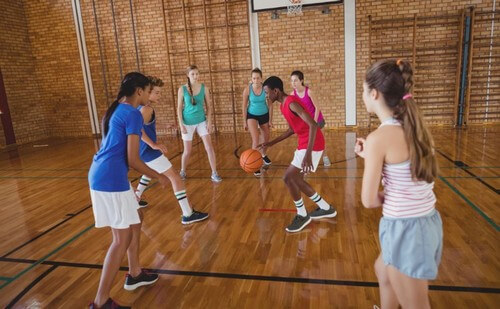The Importance of Types of Dribbling in Basketball

Dribbling is a basic move that you have to master (along with passing, shooting, and defense) if you want to become a good basketball player. But are you familiar with the different types of dribbling in basketball?
Mainly, it’s for players to advance on the court and leave the other team’s defense behind. Of course, the key is doing it without moving. Find out more about a few types of dribbling in basketball below.
When and how to dribble?
Players from any team who want to compete in basketball need to master the art of dribbling. What’s more, they have to know how to do it with both hands.

The use of both hands to dribble lets you have an exit strategy for any scenario and lets you move in the direction you want.
If you want to dribble correctly, the hand you use to push the ball has to take its shape. This is so you can handle it as you wish and use the most suitable angles (your hand should never stay straight).
It’s most convenient to use the hand that’s furthest away from the defense when dribbling. This gives the ball greater protection, especially if you use your arm that isn’t dribbling the ball.
When dribbling, you should move with the ball by slightly moving your forearm and wrist. You should also take special care when coming into contact with it. Indeed, you’ll need good control over the ball if you want to control its angle as you wish. This will make it easier for you to change its direction and your rhythm.
Finally, you should also dribble with your head held high so you can see what all of your options are. In addition to knowing basic technique, when handling the ball, you should take into account the most important rule: knowing when to dribble.
When it comes to timing, there are different opinions on the subject. Still, the general rule of thumb is if you can make a pass, you shouldn’t dribble.
Keep in mind that dribbling too much greatly impacts collective play and the concept of a team. On this basis, make sure that your players know when to dribble and impose rules that regulate it.

Types of dribbling in basketball
High dribble
It’s the most common type of dribbling since it’s carried out constantly while moving around the court.
You have to bounce the ball slightly in front of your body and next to it.
The ball should go up – more or less – to the player’s waist (or a little higher at most).
To make sure the ball keeps pace, push the ball slightly in front of your body. This way, the ball won’t be left behind while you run around the court.
The coordination between your legs and dribbling hand is crucial. Of course, your feet should follow one after the other to avoid falling over.
Read more about: The Top 5 Non-American Basketball Players
Speed dribble
Our next example from our types of dribbling is similar to the previous one. Still, the player has to move much faster, since their objective is to advance on the court as fast as possible.
It’s common knowledge that a player advances faster by running than by dribbling. As such, you’ll have to run a lot and dribble a little by pushing the ball forward. This will ensure you have as many steps as possible between each bounce.
A useful trick is to switch the hand you dribble with while keeping control of the ball. In other words, the player directs the ball and not the other way around.
Your body should lean a forward with your arm slightly in front of your body.
Control dribble
This type of dribbling is very useful in protecting the ball. It also protects your position against a defender who is stopping you from moving forward or trying to snatch the ball.
Your body should be slightly flexed looking to keep the ball.
From this position, bring your leg forward a little, as well as the arm that you aren’t using to dribble. That is, the one that’s furthest away from the defender so that you can use it to cover the ball.
Since you’ll be slightly bent over, you’ll have to dribble lower. So, what you’re really doing is using your entire body to protect the ball. In other words, you’re placing your body between the defense and the ball.
Finally, your neck should stay turned while looking at the defense and the rest of the court. This will help you to avoid any surprises from opponents who want to steal the ball from behind.
Want to know more?: Basketball Zone Defense
Other types of dribbling
Low dribble
This dribbling style involves the player bouncing the ball very low and quickly. Point guards often use it to change hands or dart away fast.
Double hand dribble
In order not to commit a double dribbling foul, a player can only use it once when they get to dribble. Players often use this one with pivots to quickly get ahead of the other team’s defense. It’s a strong and forceful dribble (often between the legs), so it’s difficult for opponents to snatch the ball.
Crossover dribble
The last example of different types of dribbling in basketball is the crossover dribble. While dribbling next to their body, the player will move sideways to find better opportunities to pass the ball or move through.
Dribbling is a basic move that you have to master (along with passing, shooting, and defense) if you want to become a good basketball player. But are you familiar with the different types of dribbling in basketball?
Mainly, it’s for players to advance on the court and leave the other team’s defense behind. Of course, the key is doing it without moving. Find out more about a few types of dribbling in basketball below.
When and how to dribble?
Players from any team who want to compete in basketball need to master the art of dribbling. What’s more, they have to know how to do it with both hands.

The use of both hands to dribble lets you have an exit strategy for any scenario and lets you move in the direction you want.
If you want to dribble correctly, the hand you use to push the ball has to take its shape. This is so you can handle it as you wish and use the most suitable angles (your hand should never stay straight).
It’s most convenient to use the hand that’s furthest away from the defense when dribbling. This gives the ball greater protection, especially if you use your arm that isn’t dribbling the ball.
When dribbling, you should move with the ball by slightly moving your forearm and wrist. You should also take special care when coming into contact with it. Indeed, you’ll need good control over the ball if you want to control its angle as you wish. This will make it easier for you to change its direction and your rhythm.
Finally, you should also dribble with your head held high so you can see what all of your options are. In addition to knowing basic technique, when handling the ball, you should take into account the most important rule: knowing when to dribble.
When it comes to timing, there are different opinions on the subject. Still, the general rule of thumb is if you can make a pass, you shouldn’t dribble.
Keep in mind that dribbling too much greatly impacts collective play and the concept of a team. On this basis, make sure that your players know when to dribble and impose rules that regulate it.

Types of dribbling in basketball
High dribble
It’s the most common type of dribbling since it’s carried out constantly while moving around the court.
You have to bounce the ball slightly in front of your body and next to it.
The ball should go up – more or less – to the player’s waist (or a little higher at most).
To make sure the ball keeps pace, push the ball slightly in front of your body. This way, the ball won’t be left behind while you run around the court.
The coordination between your legs and dribbling hand is crucial. Of course, your feet should follow one after the other to avoid falling over.
Read more about: The Top 5 Non-American Basketball Players
Speed dribble
Our next example from our types of dribbling is similar to the previous one. Still, the player has to move much faster, since their objective is to advance on the court as fast as possible.
It’s common knowledge that a player advances faster by running than by dribbling. As such, you’ll have to run a lot and dribble a little by pushing the ball forward. This will ensure you have as many steps as possible between each bounce.
A useful trick is to switch the hand you dribble with while keeping control of the ball. In other words, the player directs the ball and not the other way around.
Your body should lean a forward with your arm slightly in front of your body.
Control dribble
This type of dribbling is very useful in protecting the ball. It also protects your position against a defender who is stopping you from moving forward or trying to snatch the ball.
Your body should be slightly flexed looking to keep the ball.
From this position, bring your leg forward a little, as well as the arm that you aren’t using to dribble. That is, the one that’s furthest away from the defender so that you can use it to cover the ball.
Since you’ll be slightly bent over, you’ll have to dribble lower. So, what you’re really doing is using your entire body to protect the ball. In other words, you’re placing your body between the defense and the ball.
Finally, your neck should stay turned while looking at the defense and the rest of the court. This will help you to avoid any surprises from opponents who want to steal the ball from behind.
Want to know more?: Basketball Zone Defense
Other types of dribbling
Low dribble
This dribbling style involves the player bouncing the ball very low and quickly. Point guards often use it to change hands or dart away fast.
Double hand dribble
In order not to commit a double dribbling foul, a player can only use it once when they get to dribble. Players often use this one with pivots to quickly get ahead of the other team’s defense. It’s a strong and forceful dribble (often between the legs), so it’s difficult for opponents to snatch the ball.
Crossover dribble
The last example of different types of dribbling in basketball is the crossover dribble. While dribbling next to their body, the player will move sideways to find better opportunities to pass the ball or move through.
This text is provided for informational purposes only and does not replace consultation with a professional. If in doubt, consult your specialist.








